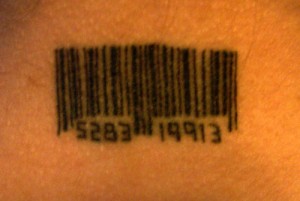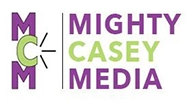
I’ll totally get one. Srsly.
I confess that I’d happily get a barcode tattooed on my neck if it meant I’d never have to fill out another ****ing health history form in a doctor’s office.
I’m totally serious.
Paper records are so … 19th century. With the advent of the current iteration of “health care reform” (which is really “health INSURANCE reform,” but that’s a blog post for another day), much has been made of the importance of Electronic Medical Record (EMR) systems in building a national Health Information Exchange (HIE).
Medicine = Acronym World. The Pentagon are pikers when it comes to fogging the battlefield with impenetrable letter-fication.
21st century health care certainly must involve a lot of easily-shared data, with health history and diagnostic information traveling literally at light speed between doctor’s offices, hospitals, and clinics. Not only does it speed care, it can ensure safety: the right record, with the right patient, makes the right care clear.
The thorny-issue part is this: whose data is it, anyway? Doctors certainly need to have full access to all the data on patients they’ve treated. Hospitals have to keep records on the people they’ve treated on their wards, in their clinics, and in their ORs. Payers (insurers, Medicare, Medicaid, et al) need data access to pay claims, track demographics, and create statistical and financial forecasts. And patients must have access to their own data, at minimum to vet it for errors, at best to own a full copy of their health history since birth to share with providers and care-givers.
I spent 8 months trying to correct an error on the report for the breast MRI I had in 2008 as preparation for my cancer surgery. The report said “family history of breast cancer.” NO. I was Patient Zero, there was NO family history of breast cancer. I fought for eight months, and I’m still only about 90% convinced the error is completely expunged. Patients need access, and we also need easy recourse to error-correction.
Back to EMRs and data exchange: access to patient data must be completely available to all concerned parties. That means doctors, healthcare facilities (hospitals, clinics, et al), and PATIENTS. However, the discussion about healthcare technology almost never includes patients. We’re considered, at best, bystanders; at worst, annoying insects.
E-Patient Dave DeBronkart – Mr. Gimme My Damn Data himself – was the 1st person I heard use the term “e-patient”. The E stands for empowered, engaged, enabled, equipped, equal – not electronic, although that’s certainly a supporting foundation for the e-patient movement. E-patients are usually placed in the “annoying insect” category by healthcare providers who don’t want to share – which can include payers, who can turn a simple record request into a Bleak-House level of bureaucracy. The most epic story in recent history, IMO at least, is Regina Holliday’s now-famous 73 Cents post (and the painting it talks about) – charging patients for access to their own data (at 73 cents a page) borders on the immoral, if not the criminal.
In the long slog through working groups, committees, implementations, and reports-to-the-board that is EMR and HIE development, don’t let the healthcare system leave us – the patients – out of the conversation.
It might be their data, too – but at root, and always, it starts with us. It’s theirs, yours … ours.



